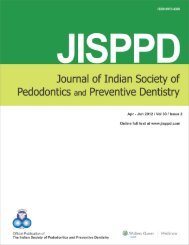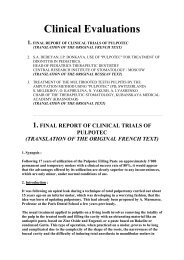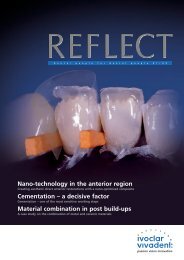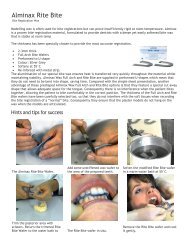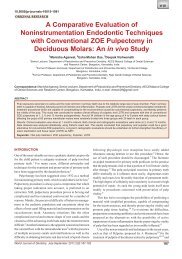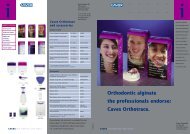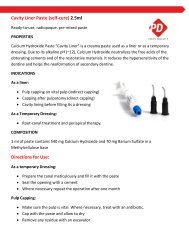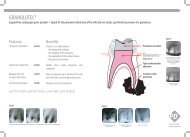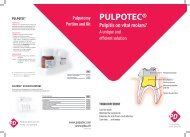temperatureresponsive
View File - universaldental.com.pk
View File - universaldental.com.pk
- No tags were found...
Create successful ePaper yourself
Turn your PDF publications into a flip-book with our unique Google optimized e-Paper software.
Four different products for gingival “tissue management”<br />
(haemostasis - contraction - retraction). Reversible <strong>temperatureresponsive</strong><br />
viscous Racegel from Septodont (second substance<br />
from the left) demonstrates its ability to undergo transient gelling on<br />
the glass plate heated to about 30 °C. In these temperature<br />
conditions, which are comparable to those in the oral cavity, this<br />
product is neither too solid nor too liquid. It is also evident that,<br />
compared to other materials, there are no problems discharging it<br />
from the thin application syringe at room temperature and that<br />
continuously uniform application is possible. Material-specific<br />
factors are very beneficial to manipulation both when using<br />
retraction cords and without them.<br />
If we ignore the fact that the most reliable<br />
method of avoiding bleeding of the sulcus tissue<br />
caused by treatment-induced irritation is to<br />
protect these structures by means of atraumatic<br />
procedures per se or to protect them by means<br />
of suitably positioned aids (wedges, cords,<br />
protective instruments, etc.), the termination of<br />
the bleeding of affected marginal gingival<br />
regions may be accelerated by means of agents<br />
which act appropriately on these regions, such<br />
as, for example epinephrine, aluminium sulfate,<br />
iron sulfate and aluminium chloride or locally<br />
applied compression by means of cotton rolls<br />
or caps, cords placed in the intracrevicular<br />
space or the like.<br />
From the clinical aspect, this means that<br />
traditional tissue management methods<br />
frequently use a combination of measures for<br />
haemostasis and retraction of the marginal<br />
gingiva in the sulcus region. The classical<br />
example is the insertion of a cord, which has<br />
previously been soaked in a haemostatic agent,<br />
in the gingival pocket. However, this<br />
combination of two, in principle very different,<br />
processes can result in tissue loss in the<br />
marginal periodontium. In particular, in the case<br />
of very thin and narrow gingival conditions,<br />
otherwise favourable impacts of individual<br />
measures may be detrimental in combination.<br />
Therefore, whenever planning manipulations in<br />
the marginal periodontium, it is advisable to<br />
consider which procedure will be the least<br />
compromising for the tissue affected. For<br />
example, the use of suitable cords in the dental<br />
sulcus region is an excellent possibility for<br />
achieving a targeted and efficient, but also<br />
gentle retraction of the gingiva and even<br />
- depending on the prevailing initial situation -<br />
for achieving an additional haemostatic action<br />
due to the compression of the microvessels.<br />
However, here it is necessary to take into<br />
account the length of time that compression<br />
acts on individual gingival regions in order to<br />
exclude the possibility of subsequent necrosisinducing<br />
ischaemia. Although mechanical<br />
retraction in combination with astringent agents<br />
is very useful for a bloodless treatment area,<br />
consideration should be paid in advance to the<br />
total amount of time that will be required.<br />
For the prudent implementation of tissue<br />
management, it is important to know that<br />
epinephrine is absorbed via exposed regions of<br />
tissue into the organism where it can have<br />
detrimental systemic effects, known as the<br />
epinephrine syndrome. This can result in<br />
tachycardia, raised blood pressure, rapid<br />
respiration, headache and anxiety or even<br />
psychological stress. In addition, the<br />
vasoconstrictive action of epinephrine only lasts<br />
for a limited period and, as a result, the vessels<br />
in the affected tissue can undergo relaxation<br />
during the decisive impression process.<br />
Although aluminium sulfate, which has been<br />
known as a method for general haemostasis for<br />
a long time, does not trigger any adverse<br />
systemic effects, but in gingival tissue it can<br />
result in an identifiable atrophy of the underlying<br />
alveolar crest. Another problem is the<br />
unpleasant taste, which not infrequently causes<br />
discomfort to the patients treated with this<br />
substance. The sulfur content can also inhibit<br />
complete setting of addition-curing silicone<br />
impression materials if aluminium sulfate is not<br />
completely removed from the regions from<br />
which an impression is to be taken.<br />
5



